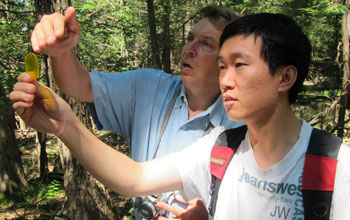Corporations, international organizations and other institutions
rely on this curiosity-driven researcher to answer societal questions.-
 |
| Joel E. Cohen lecturing at The Rockefeller University, New York City, May 2, 2013. Credit: Scott Rudd Photography © 2013 The Rockefeller University |
 |
| Measurement of tree diameter at Black Rock Forest, Cornwall, NY Credit: Joel E. Cohen |
 |
| Dr. William S. F. Schuster demonstrating use of wedge prism to Dr. Meng Xu at Black Rock Forest, Cornwall, NY Credit: Joel E. Cohen |
Download the high-resolution JPG version of the image. (2.6 MB)
In 1995, mathematical biologist Joel E. Cohen began working to create
a computerized overlay of two digital maps, one showing the
distribution of the globe's population, the other an elevation model of
the Earth. Collaborating with a geophysicist, he produced a single map
that quantified, for the first time, the world's population by
elevation.
Why did he do it? Because he could.
"Our work
was driven entirely by curiosity," says Cohen, a longtime National
Science Foundation- (NSF) funded scientist who is a professor of
populations at Rockefeller and Columbia Universities. "We published it
just for fun."
Eventually, the fun turned serious after at least
two corporations heard about it. Procter & Gamble (P&G) and
Intel Corp. both contacted Cohen after the research was published in
1998 wanting to learn more. P&G, a major manufacturer of consumer
goods, including cleaning agents, and Intel, which makes semiconductor
chips, were interested in finding out how many people live at higher
elevations, since altitude has a big impact on their products.
"Altitude
affects the formulation of laundry soap," Cohen says. "It influences
how the bubbles mix in." For Intel, "computer chips generate heat and
have to be cooled," he explains. "Cooling capacity depends on the
density of the air. The higher you go, the thinner the air, and the
less effective the air is at cooling. The results of using the data are
now part of the thermal standards for personal computers."
Furthermore,
a cancer researcher told him of a rare tumor that occurs among people
who live at higher elevations. Together, the cancer researcher, other
colleagues and Cohen used the data to help identify the number of
individuals at risk and the mechanisms causing the cancers. The
relationship involves "the decrease in oxygen tension in the bloodstream
in the neck" resulting from higher altitudes, Cohen says.
For
Cohen, the experience provided an important lesson about the need to
support basic curiosity-driven research, even if its practical
applications are not always immediately apparent.
"Nobody could
have foreseen this," Cohen says. "Nobody could have imagined these
things. Even we who were doing it couldn't imagine it. It just seemed
like a cool thing to do. But that's why it's important for people to
pursue such opportunities. The surest way to promote applications is not
to tie people's hands. If what you do is beautiful, it will turn out to
be useful."
He has seen this countless times during a long and distinguished career.
Cohen
studies groups of living beings and their interactions, including
people, insects, microorganisms, food and agriculture, all with the goal
of developing concepts for understanding populations and, ultimately,
for benefiting society. In order to do this, he and his colleagues
combine mathematical tools with observations of concrete problems in
demography, biology and epidemiology, among other aspects of
populations.
For example, Cohen has spent many years studying
food webs--diagrams of which species eat which other species--and since
1988 has been modeling the food web of Chagas disease, an illness
transmitted by a parasite that causes intestinal and cardiac problems.
"In
the absence of vaccines or practical drugs, our work has aimed to
provide people in endemic, very poor rural areas with simple ecological
strategies they can use to interrupt transmission," he says. The work,
conducted with scientists in Argentina, "was recognized by the Pan
American Health Organization, and has saved lives," he adds.
Cohen also has been testing Taylor's law--an empirical rule in ecology that describes the relationship between variance
and mean in the density of samples of organisms within a study
area--using data on bacterial populations in the laboratory and, more
recently, trees.
He is conducting his tree research at Black Rock
Forest, a nearly 4,000-acre natural living laboratory for field-based
scientific research and education 50 miles north of New York City,
operated by a unique consortium of colleges and universities, public and
independent schools, and scientific and cultural institutions.
In
2010, he decided to measure the mean population density of trees and
the variance of population density in order to compare plots at
different times. The facility had historical data in file cabinets on
paper--records Cohen describes as a "treasure"--that allowed him to see
changes over 75 years, although calculations "had not been done with
these trees in relation to Taylor's law," he says. "However, we were
delighted to find that it works very well."
To investigate why
Taylor's law described these data, the researchers tested the tree
censuses every five years against a simple mathematical model of
population dynamics that had been published in 1969, eight years after
Taylor first described his law.
"For a half century, that
mathematical model and Taylor's law remained unconnected," Cohen says.
"My colleagues and I showed that the mathematical model actually
predicted Taylor's law and described the population dynamics of the
trees very well."
Taylor's law is important in sampling
agricultural pests of commercially important crops, like cotton and
soybean, for example, because it provides guidance about how to adjust
sampling intensity to differences in the mean population density of the
pest.
"If I am a cotton grower and I am concerned about the pests
that affect my plants, then I have to sample the pests to know whether
they have reached a population density that requires using pesticide or
other treatment," Cohen says. "If I know that Taylor's law works, and
use it in my sampling design, I save money and get more information for
the same sampling effort. For practical things, like pest control, it
pays to know about Taylor's law and use it in your sampling."
Moreover,
"if variability increases with density, this could affect extinction
risks for species," he adds. "Taylor's law has been shown to apply to
cases of measles, fisheries production and pest control-down-to-earth
things where humans depend on other living species. We had better invest
in understanding how populations of other species work, as well as
populations of humans. Investing in mathematics and biology will help us
to do that."
| -- | Marlene Cimons, National Science Foundation |
Investigators
Joel Cohen
Robert Costantino
Robert Desharnais
Robert Costantino
Robert Desharnais
Related Institutions/Organizations
Rockefeller University
California State L A University Auxiliary Services Inc.
California State L A University Auxiliary Services Inc.
Related Awards
#1225529 Synchrony in Metapopulations at Multiple Time-Scales: Theory, Experiments and Field Data
#1038337 Scaling of Variability in Populations, Individuals, and Ecosystems: Taylor's Law and Beyond
#1038337 Scaling of Variability in Populations, Individuals, and Ecosystems: Taylor's Law and Beyond
Total Grants
$1,240,000
Related Websites
Laboratory of Populations:
Laboratory of Populations:
http://lab.rockefeller.edu/cohenje/
Joel E. Cohen Print Publications:
Joel E. Cohen Print Publications:
http://lab.rockefeller.edu/cohenje/cohenall
Introduction to Demography and Populations by Joel E. Cohen:
Introduction to Demography and Populations by Joel E. Cohen:
The National Science Foundation (NSF).
Guillermo Gonzalo Sánchez Achutegui
ayabaca@gmail.com
ayabaca@hotmail.com
ayabaca@yahoo.com
Inscríbete en el Foro del blog y participa : A Vuelo De Un Quinde - El Foro!

No hay comentarios:
Publicar un comentario